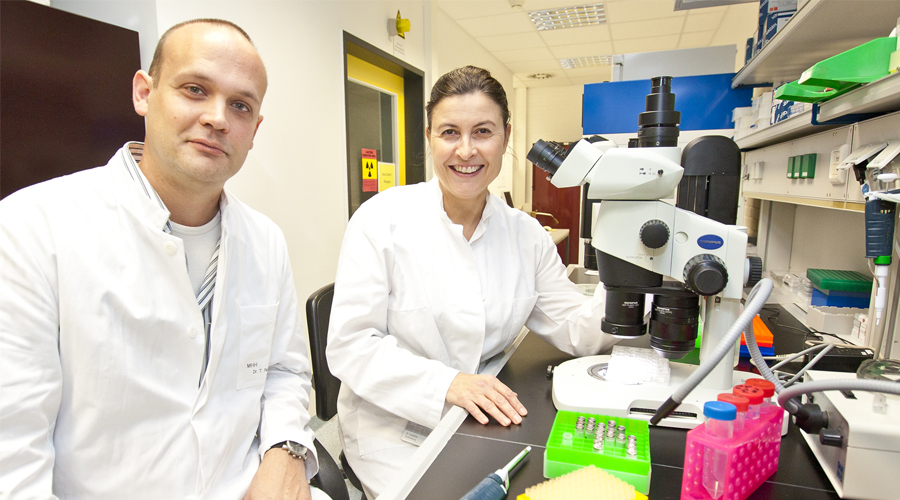| My Research Interest in RESIST |
We work on the elucidation of the molecular mechanism of innate immune receptors of the NLRP family. These immune receptors constitute a first line of defense against invading pathogens. We combine a wide range of structural and cell biological methods to understand, how NLRPs function and how their function can be modulated.
In particular we will analyse the interactions of pathogen- derived proteins with NLRPs and of small-molecule compounds that are known to inhibit selected NLRPs. Among our long-term goals is the structure-based development of lead compounds for the therapeutic modulation of the function of selected NLRPs.
PD Dr. Eschenburg in her laboratory
PD Dr. Susanne Eschenburg – Curriculum Vitae
Current Position
Undergraduate and Postgraduate Training
Academic and Research Posts
Awards and Prizes

10 Selected Publications (of > 225 original publications)
Duong M, Yu X, Teng B, Schroder P, Haller H, Eschenburg S, and Schiffer, M. Protein kinase C regulates stabilization of -catenin and its subcellular localization in podocytes. J. Biol. Chem. 2017, 292: 12100-12110.
Zumbrägel FK, Machtens DA, Curth U, Lüder CG, Reubold TF, and Eschenburg S. Survivin does not influence the anti-apoptotic action of XIAP on caspase-9. Biochem. Biophys. Res. Commun. 2017, 482: 530-535.
Reubold TF, Faelber K, Plattner N, Posor Y, Ketel K, Curth U, Schlegel J, Anand R, Manstein DJ, Noe F, Haucke V, Daumke O, Eschenburg S. Crystal structure of the dynamin tetramer. Nature 2015, 525:404-408.
Reubold TF, Hahne G, Wohlgemuth, Eschenburg S. Crystal structure of the leucine-rich repeat domain of the NOD-like receptor NLRP1: implications for binding of muramyl dipeptide. FEBS Lett 2014, 588:3327-3332.
Reubold TF, Wohlgemuth, Eschenburg S. Crystal structure of full-length Apaf-1: how the death signal is relayed in the mitochondrial pathway of apoptosis. Structure 2011,19:1074-1083.
Reubold TF, Wohlgemuth, Eschenburg S. A new model for the transition of APAF-1 from inactive monomer to caspase-activating apoptosome. J Biol Chem 2009, 284:32717-32724.
Reubold TF, Eschenburg S, Becker A, Leonard M, Schmid SL, Vallee RB, Kull FJ; Manstein DJ. Crystal structure of the GTPase domain of rat dynamin 1. Proc Natl Acad Sci U S A 2005, 102:13093-13098.
Reubold TF, Eschenburg S, Becker A, Kull FJ, Manstein DJ. A structural model for actin-induced nucleotide release in myosin. Nat Struct Biol 2003, 10:826-830.
Schonbrunn E1 , Eschenburg S1 , Shuttleworth WA, Schloss JV, Amrhein N, Evans JN, Kabsch W. Interaction of the herbicide glyphosate with its target enzyme 5-enolpyruvylshikimate 3-phosphate synthase in atomic detail. Proc Natl Acad Sci U S A 2001, 98:1376-1380. 1 Equal contribution
Schonbrunn E, Eschenburg S, Luger K, Kabsch W, Amrhein N. Structural basis for the interaction of the fluorescence probe 8-anilino-1-naphthalene sulfonate (ANS) with the antibiotic target MurA. Proc Natl Acad Sci U S A, 2000, 97:6345-6349.


